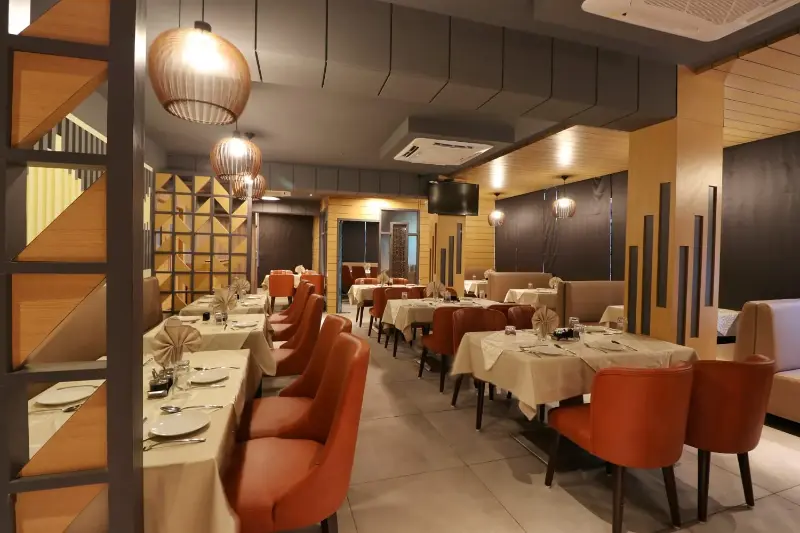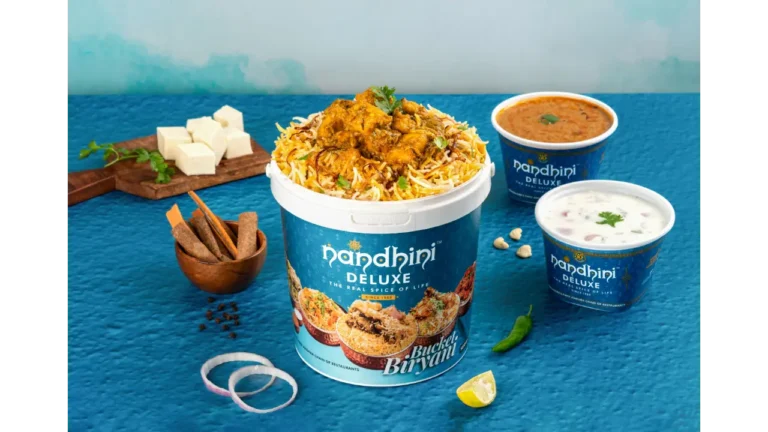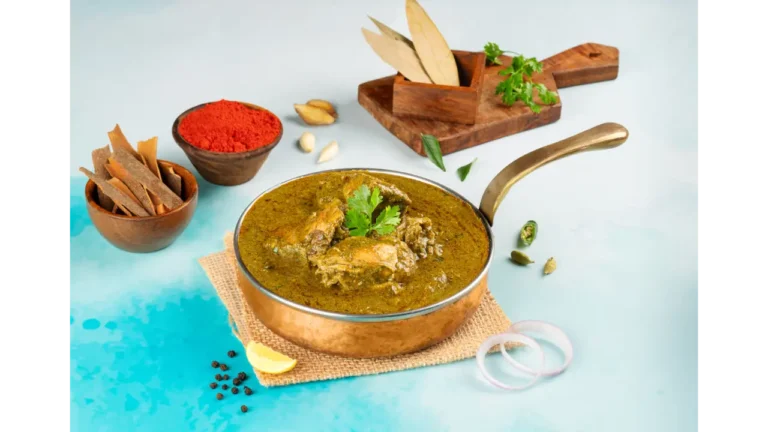Introduction
Walk into RT Nagar around lunchtime and you’ll feel it instantly — the buzz of people escaping offices and homes, the familiar heat in the air that’s not just from the weather but from kitchens sending up fiery wafts of Andhra spice. Among the many cuisines Bengaluru celebrates, Andhra food occupies a unique corner: unapologetically spicy, generous with rice, and heavy on meat. In this neighborhood, the talk often circles back to one name — Nandhini Deluxe.
What makes these meals stand out is not just the volume of rice or the redness of the curries, but the layered way they hit you: first a rush of chili, then the tang of tamarind, finally the grounding comfort of ghee and rice. People come here for biryani, for the legendary gongura mutton, for the type of fish curry that feels like it belongs on a coastal Andhra dining table. And they don’t just eat; they compare, they recommend, they return with new friends to initiate them into the fire.
This article looks at Andhra non-veg meals in RT Nagar through more than a menu lens. It breaks down the dishes, the cultural logic behind them, and why a restaurant like Nandhini has managed to set the tone for what “authentic” Andhra food means in this part of the city.
Key Takeaways
- Andhra non-veg meals in RT Nagar are built on spice, tang, and hearty rice-centered plates.
- Nandhini Deluxe is a local landmark where dishes like gongura mutton and Andhra biryani shape people’s expectations.
- The meals follow a sensory progression: chili heat, sourness, comfort — designed to keep you going back for another spoonful.
- This article explores the dishes themselves, their cultural roots, and the dining experience at Nandhini and nearby places.
Table of Contents
Mapping the Andhra Non-Veg Meal Landscape in RT Nagar
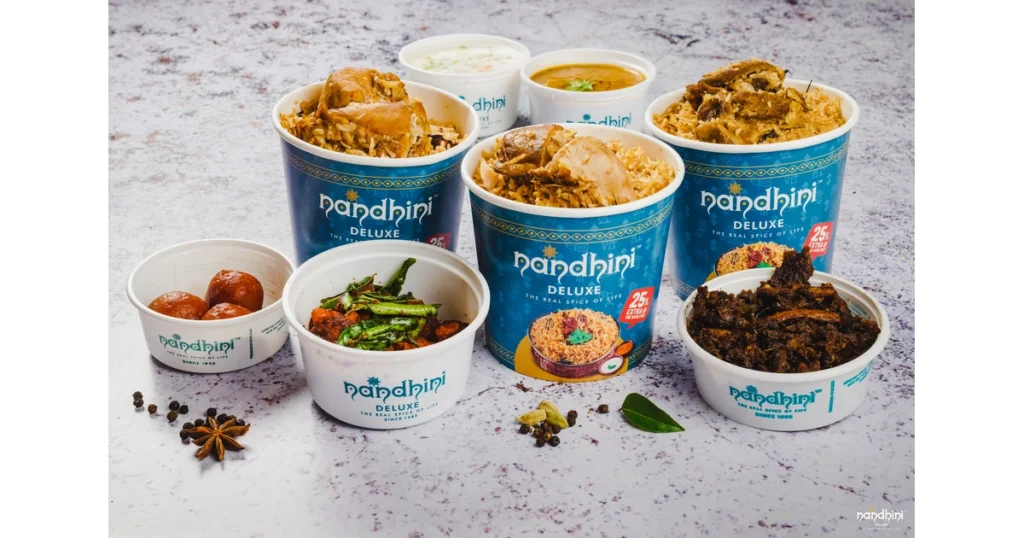
The phrase “Andhra non-veg meal” doesn’t mean just one thing. In RT Nagar, it branches into biryanis, thalis, curries, and combo packs. Each has its own logic, and understanding this helps explain why the same crowd might line up on Monday for biryani and come back on Friday for a full thali.
Variety of Andhra Non-Veg Dishes
Andhra biryani here is a sharper cousin of its Hyderabadi sibling. The rice is less oily, the spice more direct, and the meat is often cooked right with the grains, creating a punchier depth. Gongura mutton is another crowd-puller. The sorrel leaves bring a sour, earthy note that cuts straight through the richness of slow-cooked mutton. For fish lovers, chepala pulusu is the main draw: a tamarind-based curry that coats every bite of rice with a tangy, peppery finish. On the side, there’s kodi vepudu, a dry chicken fry tossed with curry leaves and coarse spices that cling to the meat.
Ingredient Storytelling
The backbone of these meals is spice, but not in a flat, one-note way. Andhra chilies are known for their brightness and heat, while tamarind adds sour layers that make the spice bearable — almost addictive. Gongura, the sorrel leaf that defines many non-veg curries, is seasonal. When it’s fresh, it brings a grassy sourness that no powder or paste can replicate. Rice isn’t just filler; short-grained sona masuri is preferred, its sturdiness holding up under ghee, gravies, and repeated mixing.
Pairings and Accents
No Andhra meal is complete without its supporting cast. Raita cools down the heat but also stretches the meal out, giving rhythm between bites. Pickled onions and papads bring crunch against the soft rice. Some thalis even feature pulihora a tamarind rice as a sharp contrast to the heavy curries. The interplay of hot, sour, cool, and crisp is what makes these meals satisfying beyond just spice.
During my own visits, I noticed that regulars rarely rush through the plate. They build it in layers: rice with curry, then a fry, then back to plain rice with a spoon of ghee. That rhythm isn’t accidental; it’s how the meal was designed back in Andhra homes, and it carries intact into restaurants like Nandhini in RT Nagar.
Inside Nandhini Deluxe’s Offering
Walk into Nandhini Deluxe in RT Nagar at lunchtime and you’ll see a rhythm in motion. Tables fill quickly, waiters balance thalis stacked with bowls, and a steady stream of biryani parcels exits through the side for delivery orders. What makes Nandhini stand out is that it doesn’t just sell Andhra food; it curates it in a way that feels both accessible for first-timers and deeply familiar for old-timers.
Signature Dishes
The menu’s anchor is gongura mutton — a dish where slow-cooked meat is cloaked in the sharp tang of sorrel leaves. Unlike generic mutton curries, this one builds tension between sour and spicy, ending in a bold flavor without being overwhelming. Right next to it on the popularity chart is their Andhra biryani. It’s not just rice with masala; the meat is cooked into the grains, each spoonful carrying chili heat, ghee, and the aroma of curry leaves. Fish curry, or chepala pulusu, rounds out the holy trinity. Made with tamarind and red chilies, its broth is glossy, fiery, and made for drenching rice.
Portioning and Presentation
The thali at Nandhini deserves special mention. It isn’t a haphazard pile; it’s a neatly organized experience. Rice sits in the center, curries on the side, with appadam (papad), raita, and pickles placed like punctuation marks. The portions are designed to stretch across multiple cycles of eating, not all at once, but in layers of mixing and resetting the palate. For delivery orders, their packaging has been tested by years of trial and error: gravies in sealed containers, rice in foil packs that keep heat trapped long enough to make a 20-minute ride tolerable.
Sourcing and Freshness
In conversations with staff, I’ve learned that the mutton cuts used here are deliberately small, bone-in, chosen for both flavor extraction and portion balance. Fish, when possible, is locally sourced seasonal carp and river fish that stand up to tamarind without falling apart. Their spice blends are partly standardized but still hand-finished in-house. That’s why two meals rarely taste identical: the chili heat may spike higher on one visit than another, depending on the batch of masala.
Sensory and Taste Architecture
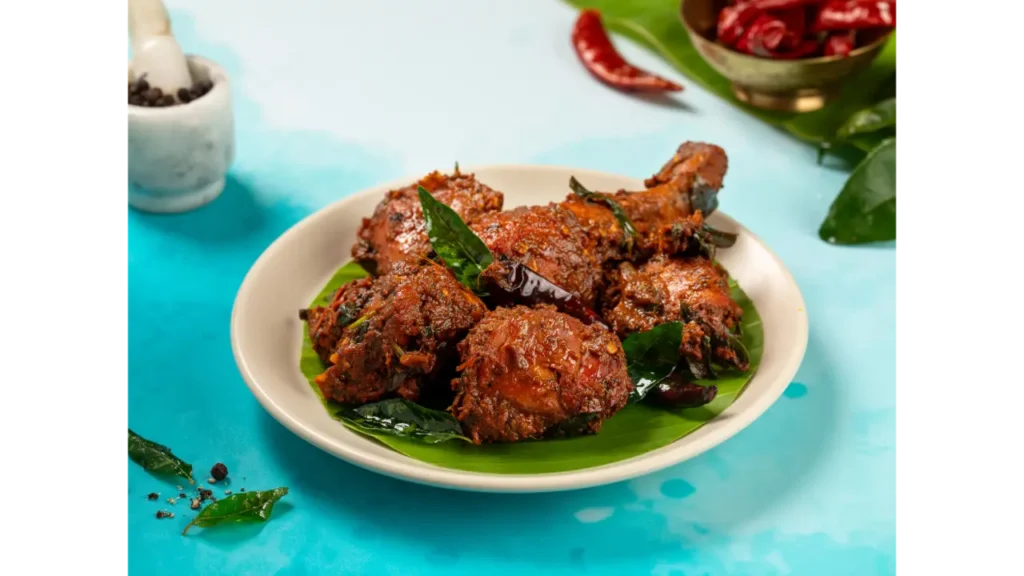
Eating an Andhra meal at Nandhini is less about rushing and more about letting the flavors unfold. There’s an architecture to how spice, tang, and fat layer themselves, and understanding it makes the meal even more satisfying.
Spice Behavior Over the Meal
The first bite of biryani announces itself with sharp chili heat that prickles the tongue. By the third or fourth spoonful, tamarind notes begin to register, tempering the fire but also prolonging it. In gongura mutton, the sourness doesn’t cancel the spice; it amplifies it by stretching its finish. The fry items, like kodi vepudu, introduce another register: dry heat, crunchy edges, bursts of black pepper. What happens is a cycle: heat builds, palate resets with raita or ghee rice, then climbs again with the next curry.
Texture and Visual Cues
Texture is where Andhra meals differ from, say, Karnataka-style non-veg meals. The gravies are thicker, clinging to rice rather than running off it. Biriyani grains stay distinct, slightly glossy with ghee but never mushy. The fish curry has a sheen of oil on top, signaling both spice and depth. Even the fry dishes are deliberately coarse: spices stick to the surface, leaving a sandy bite that keeps your mouth busy long after swallowing.
On one of my visits, I found myself slowing down halfway through the meal just to study the way the rice grains caught the masala oil. That small shimmer of the red streaks against white rice is part of why people find this food addictive. It’s not just about heat. It’s about layers of taste and texture that keep the diner hooked until the last grain.
Experience Guide for Diners
Eating Andhra food in RT Nagar isn’t just about what’s on the plate; it’s about when you go, how you order, and the kind of atmosphere you’re stepping into. A smart diner knows the rhythm of the restaurant and the quirks that make a meal smoother.
When to Go
Lunch hours are the busiest, and with good reason. By 1 p.m., the thali crowd floods in, and the atmosphere gets almost canteen-like, lively, noisy, and efficient. If you want the energy of a crowd and don’t mind a short wait, this is the time. But for those who prefer a quieter, slower meal, a late lunch around 3 p.m. gives you space without sacrificing freshness. Dinner has its own draw families and groups leaning towards biryani or combo meals, less rushed, more communal.
Atmosphere and Service
Nandhini Deluxe in RT Nagar is not a fine-dining setup, nor does it try to be. The tables are functional, the service brisk. There’s an efficiency that regulars appreciate: waiters don’t hover, but they notice when rice runs low or a side dish needs refilling. The air hums with conversations and the clatter of steel bowls. The crowd itself creates part of the experience — you’re eating alongside office-goers, students, and families who all share the same pursuit: a satisfying Andhra plate.
Delivery vs Dine-In
Not everyone in RT Nagar has the time or tolerance for a dine-in spice session. Delivery orders from Nandhini are constant, and here the restaurant has a reputation to maintain. Curries are packed thick to minimize spills, and biryani comes in foil-lined boxes that hold both heat and aroma. From personal experience, the spice intensity can feel sharper in delivery, perhaps because the heat steams inside the box during transit. That’s not necessarily a drawback — for some, it’s a bonus.
One insider tip: if you’re new to Andhra spice, dine-in is better for your first try. The ability to control pace — adding raita, stretching the meal with plain rice makes the experience less overwhelming than tearing into a sealed biryani at home.
Andhra Heritage & Cultural Layer

Andhra meals don’t just feed hunger; they carry a cultural rhythm that has been sharpened over centuries. To understand why the food tastes the way it does in RT Nagar today, it helps to know a bit about its heritage.
Andhra Non-Veg Meal Philosophy
At the core, Andhra cuisine avoids softness. Flavors here are pointed: chili for fire, tamarind for tang, gongura for sourness. Unlike cuisines that balance heat with sweetness or cream, Andhra food doubles down. Non-veg meals are built to match rice not as a neutral base, but as a partner that absorbs spice and makes it digestible. The structure of a typical meal reflects this: start with plain rice and ghee, move into pulses or sambar, and finally arrive at non-veg curries that dominate the plate.
Historical Roots
The prominence of gongura in curries is no accident. Sorrel thrives in Andhra’s soil and became a natural souring agent long before bottled tamarind pulp or vinegar were common. Similarly, the heavy reliance on chili peppers can be traced back to colonial introductions in the 16th century. Andhra kitchens adopted them faster and more aggressively than neighboring regions. Over time, coastal towns emphasized fish curries, while inland regions leaned into mutton and chicken. What you eat at Nandhini in RT Nagar today is essentially a distillation of these strands: coastal sourness meeting inland heat.
Continuity in Bengaluru
For Andhra migrants in Bengaluru, these meals became more than comfort food. They’re identity markers. Ordering a gongura mutton curry in RT Nagar is as much about nostalgia as it is about taste. The fact that places like Nandhini have standardized and scaled these flavors for a diverse crowd is what allowed Andhra food to carve out its own space in the city’s crowded dining scene.
On one of my visits, I noticed a group of diners speaking in Telugu, guiding their non-Telugu friends through the thali: “Mix that with rice first, then add this.” It wasn’t just eating, it was passing down a script of how Andhra food is meant to be consumed. That cultural transfer is as central to the meal as the spice itself.
RT Nagar Andhra Joints
RT Nagar isn’t short on Andhra food options. Over the years, several small messes and mid-sized restaurants have cropped up, each trying to capture a slice of the Andhra craving. What’s interesting is how they compare — not just in food, but in crowd, price, and dining experience.
Smaller Andhra Messes
Tucked into side lanes, these messes often serve quick thalis at pocket-friendly rates. The food can be fiery and homestyle, but consistency is a gamble. One week, you might get mutton curry that sings; the next, it may taste under-spiced or over-salted. Ambience is bare-bones, and turnover is fast. They attract bachelors, students, and office-goers who want a quick Andhra fix at minimal cost.
Mid-Sized Family Eateries
Some larger eateries attempt a more polished thali with additional side dishes. They lean on generous portions but may compromise on the finesse of flavor. Biryani is usually an add-on, not the main act. Families frequent these places, especially on weekends, when a table of four can share one large thali and supplement it with extra curries.
How Nandhini Stands Out
Nandhini Deluxe sits above both categories. It doesn’t try to be the cheapest option, but it consistently delivers the “Andhra punch” without the unpredictability of smaller messes. Compared to mid-tier eateries, its range of non-veg dishes — gongura mutton, chepala pulusu, and distinctly Andhra biryani — is wider and executed with more precision. Ambience-wise, it balances functionality with order: clean tables, brisk service, predictable quality.
Here’s a simple comparison snapshot:
| Factor | Local Messes | Mid-Sized Andhra Spots | Nandhini Deluxe RT Nagar |
|---|---|---|---|
| Price | Low | Moderate | Moderate-High |
| Consistency | Variable | Decent | High |
| Signature Dishes | Basic chicken curry | Chicken + mutton curry | Gongura mutton, biryani, fish curry |
| Ambience | Bare-bones | Family-friendly | Brisk but organized |
| Delivery | Rare or absent | Limited | Strong & reliable |
What diners here often realize is this: if you want quick and cheap, the messes serve the purpose. But if you want an Andhra non-veg meal that feels complete where spice, sourness, and presentation come together reliably, Nandhini is the safer bet.
FAQ
When people search for Andhra meals in RT Nagar, their questions are rarely just “where to eat.” They want to know what to expect, how spicy the food is, and whether they’ll survive the heat. Here are some of the most common queries — answered from real observations.
What makes Andhra non-veg biryani different?
Andhra biryani is leaner and fierier than its Hyderabadi cousin. The masala coats every grain, giving it a sharper, more immediate chili hit. At Nandhini, the biryani is cooked with the meat, so the flavors soak through rather than just sitting on top.
How spicy are the meals at Nandhini in RT Nagar?
They’re unapologetically hot. Even regulars often reach for extra raita or plain rice as a buffer. For first-timers, it’s smart to pace the meal: start with smaller curry portions, mix with rice generously, and lean on cooling sides.
What’s so special about gongura mutton?
Gongura leaves add a sourness that transforms the curry. Instead of just chili heat, you get a layered taste: tang first, spice second, meaty depth last. It’s a dish that keeps evolving as you eat more.
Can someone new to spice handle these meals?
Yes, but with adjustments. Ask for extra curd or raita. Mix rice with ghee before adding curries. Alternate bites with papad or pickles to reset your palate. Many first-timers find that after the initial shock, the flavor balance makes them want a second helping.
Is delivery worth it, or should I dine in?
For newcomers, dine-in is a safer bet. You’ll have more control over pace and sides, and the curries arrive in their intended form. Delivery is reliable, but the spice can feel sharper because of the way heat builds inside sealed packaging.
Conclusion
Andhra non-veg meals in RT Nagar aren’t just about filling a plate — they’re about experiencing a rhythm of flavor that moves from fire to tang to comfort. Among the many joints that serve these meals, Nandhini Deluxe has become the touchstone, offering consistency in dishes that demand both precision and boldness. Gongura mutton with its sour edge, biryani with its chili-soaked grains, and tamarind-rich fish curries have turned into more than menu items; they’re markers of what locals expect when they say “Andhra food.”
What keeps diners coming back isn’t novelty but reliability. Every plate follows a script that balances spice with rice, sourness with ghee, and intensity with small moments of relief like raita or papad. For regulars, this balance feels like second nature. For first-timers, it’s a challenge worth tackling — one that often leads to repeat visits.
In a neighborhood crowded with choices, Nandhini’s ability to maintain both the cultural roots of Andhra cuisine and the practical needs of Bengaluru’s fast-moving diners is what keeps it at the center of the conversation. RT Nagar may have many Andhra messes and eateries, but when it comes to a meal that feels whole, fiery, and faithful to its origins, Nandhini Deluxe remains the name locals trust.

